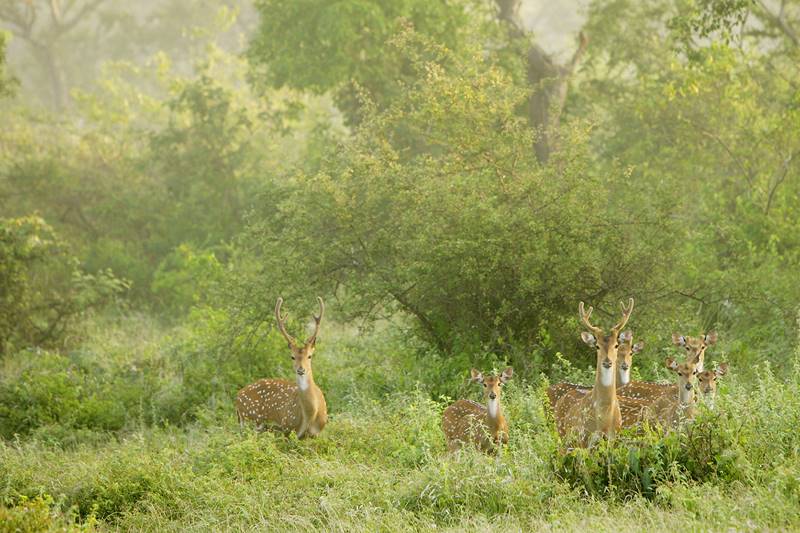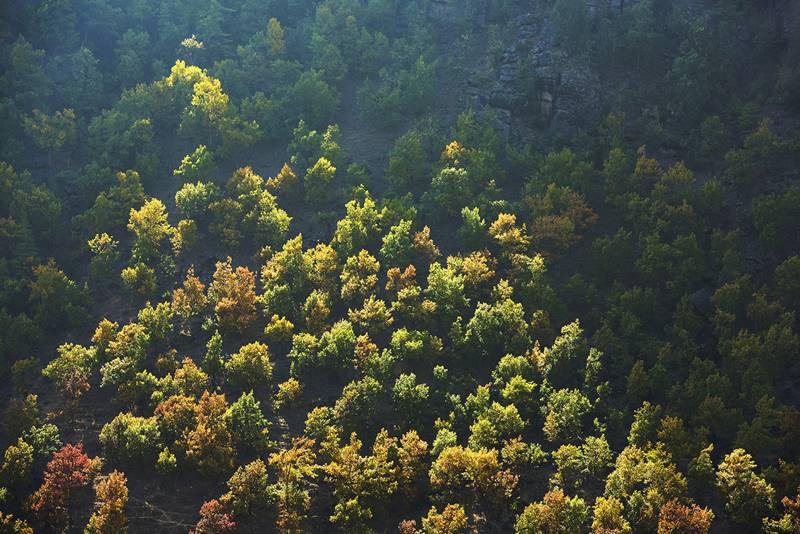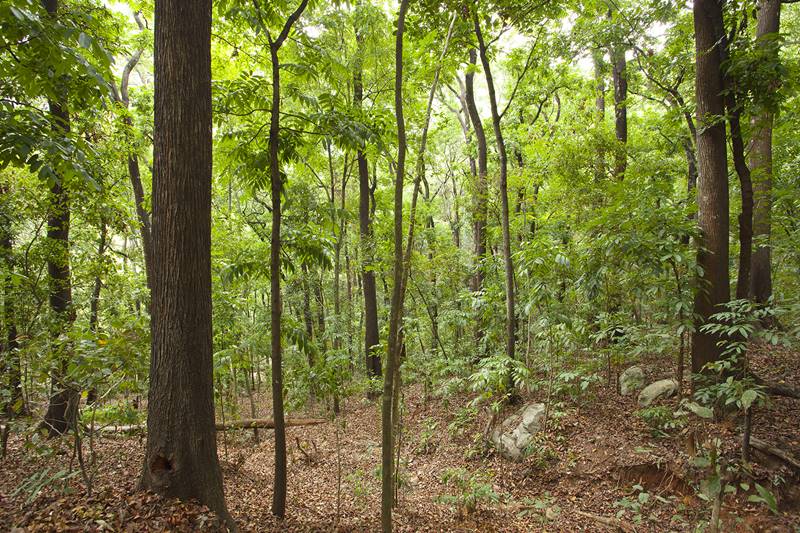COP26: As world leaders pledge to end deforestation, the Tamil Nadu forest department sets green goals for itself
Over 100 countries pledged at the COP26 in Glasgow, to end deforestation by 2030 and preserve the critical forest covers around the globe. India did not sign this commitment. But, the Tamil Nadu forest department has drawn up an ambitious plan to increase the forest cover from 24 per cent to 34 per cent, restore at least 100 different native species, and plant 330 million trees every year for the next ten years. Supriya Sahu, Principal Secretary, Environment and Forests, Tamil Nadu, shares the details with Gaon Connection.


Seen in the picture is a family of deer deep in the Mudumalai forests. Photo by Iqbal Mohamed, Founder, Light and Life Academy, Lovedale, Nilgiris.
Coimbatore, Tamil Nadu
While the world awaits the outcome of the 2021 United Nations Convention on Climate Change, also known as Conference of Parties-26, or COP26, which concludes tomorrow, November 12, at Glasgow in the United Kingdom, the Tamil Nadu forest department back home has been busy.
In a recent flurry of moves, the Tamil Nadu government and its forest department have come up with plans to further consolidate, protect and conserve its rich forest reserves, flora and fauna.
One of the decisions has been to set up a Tamil Nadu and Wildlife Crime Control Bureau with four centres in Chennai, Coimbatore, Madurai and Ramanathapuram. The other is the establishment of three state-of-the-art Rescue, Treatment and Rehabilitation Centres at Coimbatore/Mudumalai, Tirunalvelli and Tiruchirapalli. Government orders to this effect were issued on November 9 and on October 29, respectively.

In a recent conversation with Gaon Connection, Supriya Sahu, Principal Secretary, Environment and Forests, Tamil Nadu, outlined some of the measures the state government planned to implement. She said these were significant moves, and all a part and parcel of what the climate change conference, COP26, was deliberating upon, among other things – to mitigate destruction of forests and their flora and fauna. Forests have a key role in mitigating climate change and controlling the rising global temperatures, she said.
Also Read: COP26: Climate justice is the strident war cry of young activists in Bangladesh
One of the pressing concerns for the forest department was wildlife crimes that seriously destabilised the ecosystem. “There is an overwhelming threat from organised illegal wildlife activities that has a devastating impact on the ecosystem of forests. The Tamil Nadu and Wildlife Crime Control Bureau will counter that,” said the principal secretary.
The Rescue, Treatment and Rehabilitation Centres on the other hand, will look after the health of the forest and its animals from within. Most importantly, these establishments will bring about a paradigm shift in the way we look at forest management and conservation issues,” she stated.
Tamil Nadu has 15 wildlife sanctuaries, 15 bird sanctuaries, five tiger reserves, four elephant reserves, five national parks and three biosphere reserves.
From Captivity to Conservation
The state’s forest department has seen unexpected action in the past few months that has reinforced its need to step up its conservation efforts and have a concrete and well planned strategy to pursue it.
In early August 2021, Tamil Nadu forest officials, wildlife enthusiasts and local inhabitants, watched with bated breath as Rivaldo, a wild elephant who was being treated for injuries in captivity for three months, was rewilded into the Mudumalai Forest Reserve in the Nilgiris. Officials of the Tamil Nadu Forest Department are elated that Rivaldo has taken well to the wild again and has not been seen near human habitation for a while now.

More recently, on October 15, after a nail- biting 21 days of hide and seek, forest department personnel tracked down, tranquilised and captured T 23, a 13-year-old wounded tiger, believed to have killed four people in the Nilgiris.
Also Read: Tiger T-23 and its tale
T 23 is currently recuperating from its injuries at Chamundi Animal Rescue and Rehabilitation Centre at Koorgalli, Karnataka, about 100 kilometres away. There are plans to rewild T 23 too, ultimately.
“Rewilding is a sustainable conservation effort, and climate change is about sustainability,” Sahu said. Besides the rewilding of Rivaldo and the capture of T 23, the principal secretary said there were frequent incidents where animals were injured, orphaned or separated from their herd.
“So far, the only option the forest department had was to bring such animals into a camp where they usually stay all their lives. How can we maintain animals for their lifetime? It is detrimental to the animals and not a good thing for conservation,” the bureaucrat stated.
According to her, the Government of Tamil Nadu has consciously shifted its approach from captivity to conservation.
The conservation policy also extends to the flora. “Invasives have taken over large tracts of the forest and for the first time perhaps, the government is planning an ‘invasive policy’ where the forests will be digitally mapped highlighting the areas where invasive vegetation is rampant. Experts in the matter will determine the steps to be taken, the resources required to implement the strategies on the ground, and so on,” Sahu explained.
The aim is to strengthen the forest from within, plant more native species and revive water bodies that have dried up inside the forests, Sahu explained.
“We can’t be silent spectators. Time is running out. We made a presentation to the chief minister about these issues, and there was a clear consensus that steps should be taken to address each of the issues threatening the ecosystem of forests and their inhabitants,” she added.
Climate change, forests and wildlife
At the recent climate summit that concludes on November 12, forests have figured prominently in the discussions. A report by National Geographic titled Will the COP26 global deforestation pledge save forests?
quotes the World Resources Institute ( WRI), a global research non-profit organisation, based in Washington DC, USA. In an article that the WRI published in 2018, it was written that the world’s forests remove approximately 20 per cent of global emissions from the atmosphere every year. Growing more forests and reviving others will remove some more emissions, the report said.

“Climate change is impacting forests in a big way and they are getting degraded from within,” concurred Sahu. “Many natural resources such as native plants have disappeared with the invasion of non-native species of flora in the forests, which do not support any biodiversity and have overwhelmed indigenous plants. Water sources are drying up and this is often why animals stray out of the forests and there is animal-human conflict,” she said.
The senior bureaucrat was very firm on the participation of local communities. “If it is only a government agenda, it will be short-lived. If you take any successful environmental initiative in the world, there are communities behind it,” she pointed out.
Also Read: Taking Trash to Task: A dumpyard in the Nilgiris hills transforms into a waste management park
Supriya Sahu became a household name in the Nilgiris when at the turn of the century, as the collector of the Nilgiris, she launched Operation Blue Mountain, to ban the use of plastic. “Once the local communities bought into the reason why plastic was harmful to the environment, the drive became a success,” she said.
In 2003, the people of the Nilgiris, when she was collector, planted 42,182 trees and created a new Guinness World Record. ‘Climate Change’ was not even a thing then,” she smiled.
About the Rescue, Treatment and Rehabilitation Centres Sahu explained that a detailed project report would be first prepared, before moving forward. “We will seek expertise, both nationally and internationally, study models of such centres and reach out to wildlife institutions, the ministry, and other experts, after which we will proceed,” she said.
Finding a space near the forest was the first thing to do as rewilding of animals would be easier. The centres would be well equipped and be a one-stop treatment and rehabilitation space, for animals and birds of all shapes and sizes, and it would be a space where vets, scientists, and wildlife experts could function and live in comfort, Sahu explained.
“The most important function of training staff would happen there. SOPs (Standard Operating Procedures) would be put in place and everything would be based on fundamental scientific wildlife principles and techniques,” she said.
“The experience we had with Rivaldo and T 23 has given us a lot of insights into what needs to be done. The centres will be professionally managed and run,” Sahu added.
Technology can help conservation
Coming back to COP26, Sahu pointed out how one of the goals of the climate change conference was to draw up resolutions, set specific targets and step up the use of technology to help in conservation and environmental protection.
Also Read: Community radio helps people in remote areas in Uttarakhand and the Nilgiris speak up and be heard
“The centres we have spoken of will also work on technologies. The GPS-enabled radio collar that was put on Rivaldo before he was rewilded was made in Germany. The drones helped the forest officials track down and finally get to T 23,” she explained. “I am sure we can make them here, too. At least these centres will help facilitate study and research and development. We need to develop our own methods that work for our kind of environment,” she said.
The forest department has specific goals. “We are talking about increasing the forest cover from 24 per cent to 34 per cent; there are plans to restore at least 100 different native species to the forests that are almost lost due to invasive species of vegetation, and planting thirty three crore trees every year for the next ten years. What will tie all our plans together is local participation,” Sahu said.
“When heads of state make announcements and set goals and targets, it will be talked about. But, only when these goals and targets become a people’s campaign, is there any hope for real success,” she concluded.

